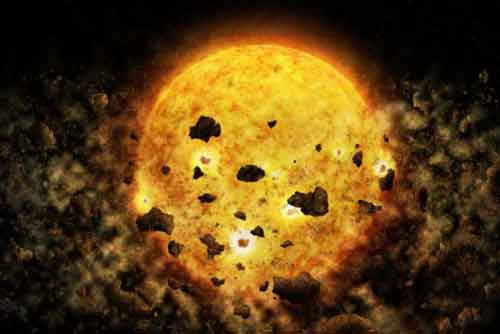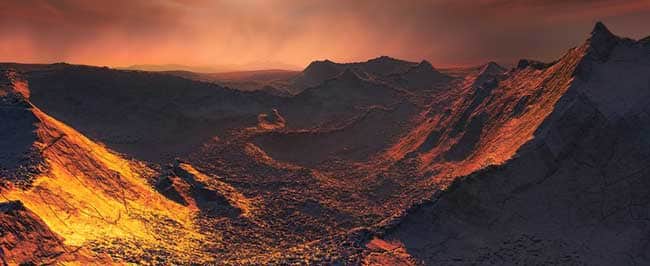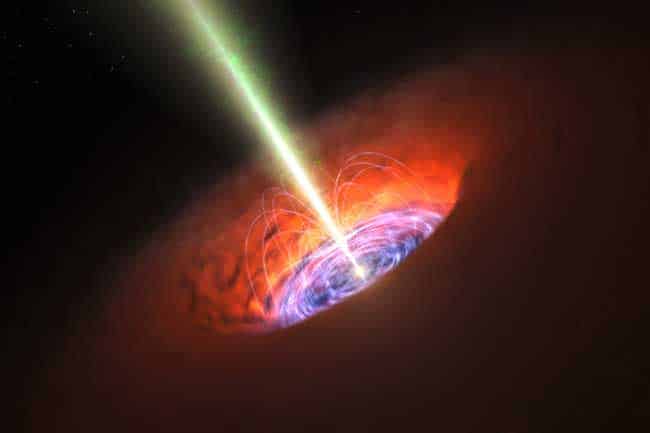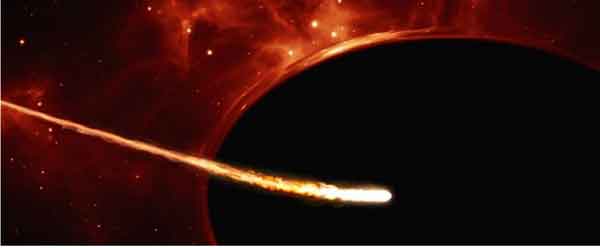Astronomers are watching a delayed broadcast of a spectacular outburst from the unstable, behemoth double-star system Eta Carinae, an event initially seen on Earth nearly 170 years ago.
Dubbed the “Great Eruption,” the outburst first caught the attention of sky watchers in 1837 and was observed through 1858. But astronomers didn’t have sophisticated science instruments to accurately record the star system’s petulant activity.
Luckily for today’s astronomers, some of the light from the eruption took an indirect path to Earth and is just arriving now, providing an opportunity to analyze the outburst in detail. The wayward light was heading in a different direction, away from our planet, when it bounced off dust clouds lingering far from the turbulent stars and was rerouted to Earth, an effect called a “light echo.” Because of its longer path, the light reached Earth 170 years later than the light that arrived directly.
The observations of Eta Carinae’s light echo are providing new insight into the behavior of powerful massive stars on the brink of detonation. The views of the nearby erupting star reveal some unexpected results, which will force astronomers to modify physical models of the outburst.
“When the eruption was seen on Earth 170 years ago, there were no cameras capable of recording the event,” explained the study’s leader, Armin Rest of the Space Telescope Science Institute in Baltimore, Md. “Everything astronomers have known to date about Eta Carinae’s outburst is from eyewitness accounts. Modern observations with science instruments were made years after the eruption actually happened. It’s as if nature has left behind a surveillance tape of the event, which we are now just beginning to watch. We can trace it year by year to see how the outburst changed.”
The team’s paper will appear Feb. 16 in a letter to the journalNature.
Located 7,500 light-years from Earth, Eta Carinae is one of the largest and brightest star systems in our Milky Way galaxy. Although the chaotic duo is known for its petulant outbursts, the Great Eruption was the biggest ever observed. During the 20-year episode, Eta Carinae shed some 20 solar masses and became the second brightest star in the sky. Some of the outflow formed the system’s twin giant lobes. Before the epic event, the stellar pair was 140 times heftier than our Sun.
Because Eta Carinae is relatively nearby, astronomers have used a variety of telescopes, including the Hubble Space Telescope, to document its escapades. The team’s study involved a mix of visible-light and spectroscopic observations from ground-based telescopes.
The observations mark the first time astronomers have used spectroscopy to analyze a light echo from a star undergoing powerful recurring eruptions, though they have measured this unique phenomenon around exploding stars called supernovae. Spectroscopy captures a star’s “fingerprints,” providing details about its behavior, including the temperature and speed of the ejected material.
The delayed broadcast is giving astronomers a unique look at the outburst and turning up some surprises. The turbulent star system does not behave like other stars of its class. Eta Carinae is a member of a stellar class called Luminous Blue Variables, large, extremely bright stars that are prone to periodic outbursts. The temperature of the outflow from Eta Carinae’s central region, for example, is about 8,500 degrees Fahrenheit (5,000 Kelvin), which is much cooler than that of other erupting stars. “This star really seems to be an oddball,” Rest said. “Now we have to go back to the models and see what has to change to actually produce what we are measuring.”
Rest’s team first spotted the light echo while comparing visible-light observations he took of the stellar duo in 2010 and 2011 with the U.S. National Optical Astronomy Observatory’s Blanco 4-meter telescope at the Cerro Tololo Inter-American Observatory (CTIO) in Chile. He obtained another set of CTIO observations taken in 2003 by astronomer Nathan Smith of the University of Arizona in Tucson, which helped him piece together the whole 20-year outburst.
The images revealed light that seemed to dart through and illuminate a canyon of dust surrounding the doomed star system. “I was jumping up and down when I saw the light echo,” said Rest, who has studied light echoes from powerful supernova blasts. “I didn’t expect to see Eta Carinae’s light echo because the eruption was so much fainter than a supernova explosion. We knew it probably wasn’t material moving through space. To see something this close move across space would take decades of observations. We, however, saw the movement over a year’s time. That’s why we thought it was probably a light echo.”
Although the light in the images appears to move over time, it’s really an optical illusion. Each flash of light is reaching Earth at a different time, like a person’s voice echoing off the walls of a canyon.
The team followed up its study with spectroscopic observations, using the Carnegie Institution of Washington’s Magellan and du Pont telescopes at Las Campanas Observatory in Chile. That study helped the astronomers decode the light, revealing the outflow’s speed and temperature. The observations showed that ejected material was moving at roughly 445,000 miles an hour (more than 700,000 kilometers an hour), which matches predictions.
Rest’s group monitored changes in the intensity of the light echo using the Las Cumbres Observatory Global Telescope Network’s Faulkes Telescope South in Siding Spring, Australia. The team then compared those measurements with a plot astronomers in the 1800s made of the light brightening and dimming over the course of the 20-year eruption. The new measurements matched the signature of the 1843 peak in brightness.
The team will continue to follow Eta Carinae because light from the outburst is still streaming to Earth. “We should see brightening again in six months from another increase in light that was seen in 1844,” Rest said. “We hope to capture light from the outburst coming from different directions so that we can get a complete picture of the eruption.”
Rest’s team consists of J.L. Prieto, Carnegie Observatories, Pasadena, Calif.; N.R. Walborn and H.E. Bond, Space Telescope Science Institute, Baltimore, Md.; N. Smith, Steward Observatory, University of Arizona, Tucson; F.B. Bianco and D.A. Howell, Las Cumbres Observatory Global Telescope Network, Goleta, Calif., and University of California, Santa Barbara; R. Chornock, R.J. Foley, and W. Fong, Harvard-Smithsonian Center for Astrophysics, Cambridge, Mass.; D.L. Welch and B. Sinnott, McMaster University, Hamilton, Ontario; M.E. Huber, Johns Hopkins University, Baltimore, Md.; R.C. Smith, Cerro Tololo Inter-American Observatory, National Optical Astronomy Observatory, La Serena, Chile; I. Toledo, Atacama Large Millimeter Array (ALMA), Chile; D. Minniti, Pontifica Universidad Catolica, Santiago, Chile; and K. Mandel, Harvard-Smithsonian Center for Astrophysics, Cambridge, Mass., and Imperial College London, U.K.
For images and more information about Eta Carinae’s light echo, visit:
https://hubblesite.org/news/2012/12
The Space Telescope Science Institute (STScI) in Baltimore, Md., conducts Hubble Space Telescope (HST) science operations. HST is a project of international cooperation between NASA and the European Space Agency. NASA’s Goddard Space Flight Center in Greenbelt, Md. manages the telescope. STScI is operated by the Association of Universities for Research in Astronomy, Inc., in Washington, D.C.






